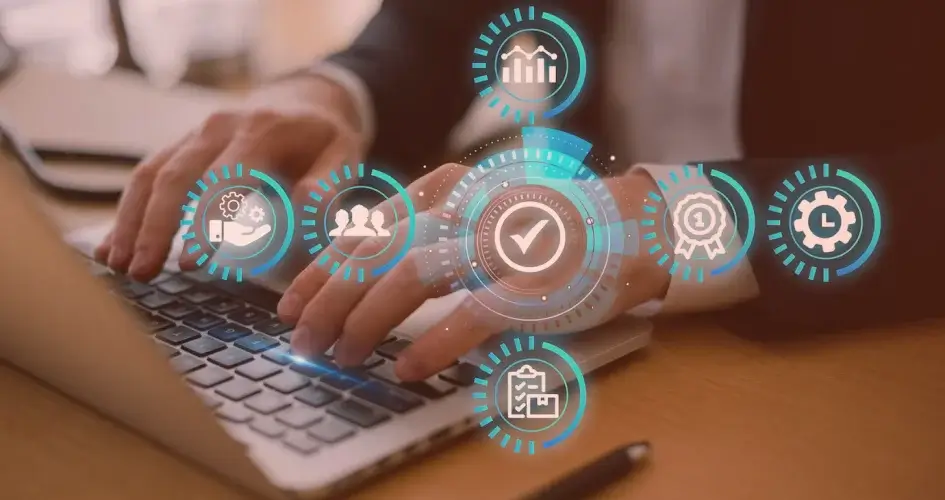The shift to remote teams has been significant in software development, with around 42.98% of software engineers working from home as this working system offers increased productivity, cost savings, flexibility, and diversity.
Yet, managing a remote team presents unique challenges, such as communication and collaboration.
Regardless, the critical question is how to get results from a remote development team effectively.
The key lies in understanding the dynamics of remote work to create a coordinated team that works seamlessly across different time zones and spaces.
In this blog, we’ll explore practical ways to build and manage a high-performing software development team remotely that is not only productive but also connected.
Laying the Foundation for Your Remote Team Success
Laying the foundation for a remote team’s success is vital in determining how effectively you can get results from a remote development team.
This foundation is built on three key pillars.
1. Remote Hiring Screening
Hiring for a remote team demands a focus on specific traits and skills.
Your candidates should have the necessary technical expertise and demonstrate strong communication skills, self-discipline, and the ability to work independently.
During the hiring process, simulate remote work scenarios to assess how candidates handle tasks and communication.
Also, diversity in skill sets and backgrounds can lead to more innovative solutions and a richer team dynamic.
When selecting team members, consider how they will fit into the existing team structure and company culture.
Look for individuals who are technically proficient, adaptable, proactive, and open to collaboration.
Ensuring all team members commit to their goals and clearly understand their software development roles and responsibilities is crucial too.
2. Comprehensive Onboarding
Implementing a structured onboarding process is vital in how to get results from the remote development team.
Once hired, the onboarding process should discuss how new team members can familiarize themselves with technical aspects, the company culture, and workflow.
Valuable onboarding for remote teams often includes:
- Virtual meet-and-greets
- Comprehensive guides to company practices, tools, and resources
- Clear explanations of communication protocols
Regular check-ins and feedback during the initial phase are essential.
You can create an onboarding buddy program to help new hires feel they belong.
Moreover, the onboarding process should emphasize the importance of self-motivation and time management.
3. Essential Technologies
The proper set of software development technologies is fundamental for a remote team’s efficiency.
These tools facilitate various aspects of software development, from coding and collaboration to project tracking and communication, for example:
- GitHub and GitLab are necessary for coding and version control.
- Jira or Trello helps organize tasks, track software development lifecycle, and set deadlines.
- Slack enables instant messaging and file sharing for real-time collaboration.
- Zoom or Google Meet are popular choices for video conferencing.
- Google Drive or Dropbox are essential for collaboration and sharing documents, files, or other resources.
4. Establishing Clear Communication Channels
To learn how to get results from your remote development team, prioritize regular and transparent communication.
Clear communication means setting up effective channels for both formal and informal communication.
Establishing regular check-ins, such as daily stand-ups or weekly team meetings, helps keep everyone aligned and informed about the project’s progress and any challenges faced.
It’s essential to have a clear protocol for communication, defining which tool to use:
- Email for formal communications
- Instant messaging apps for quick queries
- Calls for in-depth discussions or problem-solving sessions
Effective Project Management
Effective project management ensures that remote teams remain flexible, collaborative, and productive, regardless of their physical location.
#1. Adapting Agile Methodologies
Mastering how to get results from the remote development team involves adapting your leadership style to a virtual environment.
Agile methodologies, traditionally used in co-located environments, can be effectively adapted for remote teams.
The essence of Agile – flexibility, continuous improvement, and customer-centricity – remains the same, but the implementation requires some adjustments.
For instance, you can do daily stand-ups via video calls or asynchronously, where team members post updates at a fixed time each day.
The key is to keep these meetings focused and efficient.
Adapting Agile in a remote environment also means emphasizing documentation more.
Since team members can’t have impromptu discussions at their desks, documenting discussions, decisions, and action items becomes vital for maintaining clarity.
#2. Balancing Synchronous and Asynchronous Work
Synchronous communication, such as video calls or live chats, is essential for discussions requiring:
- Immediate feedback
- Brainstorming sessions
- Complex problem-solving
However, relying solely on synchronous communication can be disruptive and inefficient, mainly when team members are spread across different time zones.
Asynchronous communication, on the other hand, lets team members contribute at a time that suits their schedule and work rhythm, but it lacks spontaneity.
The key to balancing both communication types is setting clear expectations and guidelines.
Your teams should agree on which situations require synchronous communication and when asynchronous methods are more appropriate.
For example, urgent issues warrant a quick video call, while status updates or feedback on non-urgent items can be handled asynchronously.
Cultivating Collaboration and Team Spirit
The secret to how to get results from the remote development team lies in fostering a sense of community despite the physical distance.
Building a solid collaboration and team spirit requires intentional efforts.
Collaboration hinges on practical communication tools.
They facilitate real-time cooperation where all team members can contribute equally regardless of location.
Another strategy is to define when and how to:
- Use different communication tools
- Set up regular team meetings
- Ensure everyone understands the processes for sharing ideas and feedback
For instance, using a shared digital whiteboard during brainstorming sessions can replicate the experience of in-person collaboration.
It’s also important to encourage an inclusive communication culture.
All team members should feel comfortable sharing their ideas and feedback, knowing their contributions are valued.
Knowing how to get results from the remote development team means setting up efficient and regular check-ins.
Regular check-ins and one-on-one meetings help understand each team member’s perspective and address any collaboration challenges they might face.
Organizing virtual team-building activities can create a sense of camaraderie among team members, such as:
- Virtual coffee breaks
- Informal chat sessions
- Online games
These activities allow team members to interact personally beyond work-related discussions.
Ensuring Continuous Growth and Development
Fostering a culture of continuous growth and development can enhance the skills and knowledge of the team members, ensure their work aligns with the team’s goals, and make them feel supported in their professional journey.
To do this, you need to know:
1. Importance of Continuous Learning or Peer-to-Peer Learning
Continuous learning involves staying updated with the latest software development methodologies, technologies, and industry trends.
Meanwhile, peer-to-peer learning means team members sharing knowledge and skills with each other.
Facilitate these through virtual ‘lunch and learn’ sessions, where team members present on knowledgeable topics, or through collaborative platforms where they can share resources and tutorials.
Both strategies are helpful to enhance your team’s skills with updated knowledge and fresh perspectives.
Furthermore, both approaches strengthen team bonds and collaboration.
2. Effective Remote Performance Reviews
Performance reviews don’t just discuss work assessment.
Instead, they should:
- Provide constructive feedback
- Set clear goals
- Discuss career development plans
Effective remote performance reviews involve regular check-ins, not annual or bi-annual reviews.
This helps address issues promptly and track the team member’s progress and challenges.
During these reviews, discussing how the individual’s work contributes to the team’s and the company’s goals can provide a sense of purpose and direction.
Most importantly, feedback should be a two-way street.
You can encourage team members to provide feedback about their roles, team members’ responsibilities, or the company.
Overcoming Remote Work Challenges
Overcoming remote work challenges involves effective conflict resolution strategies and promoting a healthy work-life balance.
The goal is to ensure the team works efficiently and maintains a positive and supportive work environment.
1. Conflict Resolution in a Remote Setting
Resolving conflicts in a remote setting can be more challenging due to the lack of face-to-face interaction and potential misunderstandings arising from digital communication.
The first step is acknowledging and addressing the issue before it escalates promptly.
It might require setting up a video call with the involved parties to discuss the matter openly and transparently.
Active listening is important in resolving conflicts remotely.
Each party should have the opportunity to express their perspective without interruption.
So, focus on understanding the root cause of the conflict rather than just the symptoms by asking clarifying questions and refraining from making assumptions.
Finding a resolution might require a mediator, such as a team leader or HR representative, especially if the conflict is complex.
The mediator can provide an unbiased perspective and help guide the discussion towards a constructive resolution.
After resolving the conflict, remember to have a follow-up to ensure that the agreed-upon solutions are implemented, and the parties involved have moved past the issue.
2. Promoting Work-Life Balance
Promoting work-life balance is crucial for the team’s well-being and productivity.
Managers should focus on how to get results from the remote development team by setting clear boundaries between work and personal life.
Encouraging team members to have a dedicated workspace and to stick to regular working hours helps maintain these boundaries.
Managers should lead by example by not sending work-related communications outside regular working hours.
This sets a precedent for the team and helps in preventing a culture of overwork.
Also, you can regularly check team members’ well-being through one-on-one meetings.
But the discussions are not just about work but also about coping with remote work and any challenges they face.
Don’t forget to encourage team members to take regular breaks and use their vacation time.
These two activities help prevent burnout and ensure team members have time to recharge.
Conclusion
Understanding how to get results from your remote development team starts with a few key elements.
The goal is to have a team that gets the job done and enjoys working together, no matter where they are.
To recap, here are ways to have a connected and productive remote development team:
- Pick the right people for your team who are good at their work and fit well with everyone else.
- Invest in suitable tools, so everyone stays on the same page, whether for planning, coding, or just talking to each other.
- Adapt agile methodologies and balance synchronous and asynchronous work.
- Arrange several formal and informal activities to build a sense of community among team members.
- Handle disagreements and ensure work doesn’t take over everyone’s life is also important.
Want to start your software project without the complexities of hiring and managing a remote development team?
Intelivita offers the perfect solution!
With over a decade of experience crafting scalable software solutions, we’re the reliable choice for businesses across the globe.
Our expert team is equipped to handle your project needs efficiently, from ideation to deployment.
Choose Intelivita for a hassle-free development experience and watch your ideas transform into impactful digital solutions.
Contact our experts and start your project today!





